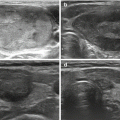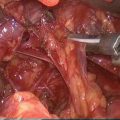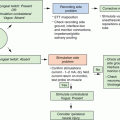Fig. 9.1
Volume reduction at 6-month follow-up after a single RFA session performed by moving-shot technique, according initial nodule volume
To summarize, in our opinion the optimal volume for submitting patients to thermal ablation is less than 20 mL (provided the nodules are responsible for compressive or aesthetic discomfort). Larger nodules can be effectively treated, bearing in mind that volume reduction could only be partial, but that it could be enough to relieve compressive symptoms, which, in most cases, is the primary objective of thermal ablation, and that more treatment sessions could be performed in order to obtain further reduction in size.
9.2.3 Is Thermal Ablation Better Than PEI in Cystic Nodules? Is There a Limit in the Solid/Colloid Ratio for Selecting Nodules to Submit to Mini-Invasive Procedures?
Sung initially reported a superiority of PEI vs. RFA in cystic nodules, but in their first experience, internal fluid was not aspirated before RFA [41]. In a more recent prospective trial of the same authors, at six-month follow-up volume reduction was 96.9 % in the PEI group and 93.3 % in the RFA group [42].
PEI is less effective for treating thyroid nodules with a larger solid component [18], so further thermal ablation could be required to achieve significant shrinkage [43, 44].
Laser
Dossing et al. randomized 44 cystic nodules to single aspiration with or without subsequent LTA. A reduction to a volume ≤ 1 ml was reported in 18 % in the aspiration group and in 68 % of the LTA group (thanks to a greater reduction of the solid part of the nodules induced by LTA) [45].
In summary, no clear superiority of a technique over the other in cystic nodules has been demonstrated, but PEI is by far less expensive than thermal ablation; therefore it is definitely preferable. Only large mixed nodules with a considerable solid portion could be sequentially treated by PEI and thermal ablation to obtain a more complete volume reduction.
9.2.4 How Frequent Is Nodule Regrowth? How Long Does Volume Reduction Last?
Radiofrequency
Lim et al. followed 111 patients for up to 4 years; a regrowth (defined as a > 50 % increase in the volume compared to initial volume) was recorded in 5.6 % of the patients. The regrowth generally affected the peripheral areas of the nodule, which had been undertreated [29].
Laser
Valcavi et al. in a retrospective 3 year follow-up reported a regrowth (defined as an increase to a volume larger than that before treatment) in 9 % of the subjects [38]; 5 % of 101 nodules treated by Papini et al. showed a regrowth (defined as a >20 % increase vs. the one-year posttreatment volume) 36 months after a single LTA session [37].
In summary, the effects of thermal ablation generally last over time, and a regrowth of the treated nodules occurs in only 5–10 % of cases. The regrowing nodules can be further treated by thermal ablation or surgically; in few of our patients who were operated on because of a poor response to RFA, no scars were found in the extranodular tissue which could impair the outcome of the surgery. This clinical observation is in agreement with the findings of Holmer et al. who in experimental animals showed a clear demarcation between areas of radiofrequency induced necrosis and the surrounding vital tissue [28].
9.2.5 Is a Single Treatment Session Enough? How Many Repeated Treatment Sessions Are Required to Significantly Increase the Nodule Volume Reduction? How Long After the First Procedure Can a Second Treatment Be Planned?
Radiofrequency
In 58 out of 111 patients reported by Lim et al., more than one treatment session (mean 2.2 ± 1.4) was required to achieve an adequate shrinkage of the nodule, and the need of multiple treatments was related to the initial volume of the nodule [29].
Hu HY enrolled 30 patients with a nodule volume of about 13 mL, randomly assigned to receive one or two treatments; at six months volume reduction was 70.2 +/− 13.2 % in the group assigned to one treatment, while in the patients who received two treatment sessions one month apart, the volume reduction was 78.3 %. Thus, a second treatment produced a slight but not significant further benefit [46]. We can speculate that the second session was performed too early after the first treatment.
Laser
Dossing et al. showed that the volume reduction induced by three monthly LTA sessions was slightly but significantly greater than that induced by a single session (58 % vs. 45 %, p = 0.03) [47].
In a series of 77 patients with very large nodules (mean volume about 55 ml) treated by two or three LTA cycles (each consisting of three sessions 1 month apart), volume reduction was 43 % after one cycle, 72 % after two cycles, and 81 % after three cycles [48].
In summary, a second or third procedure is able to obtain a further volume reduction of 15–20 %, which could lead to a global reduction of about 80 % or more; in our opinion more treatment sessions should be considered for larger nodules, when a significant portion of untreated tissue remains after the first procedure and/or when the patient complains of incomplete resolution of the symptoms. However, in these cases, a careful analysis of the cost–effectiveness should be performed, taking into account the cost of the many devices required, the clinical condition of the patients, and the aim of the treatment.
As regards the timing of a second treatment, up until now no studies have specifically investigated this issue, but, as the maximum volume reduction is obtained between 6 and 12 months after the first thermal ablation, it would be reasonable to plan it after this period of follow–up.
9.2.6 Are the Hyperfunctioning Nodules Suitable for Thermal Ablation?
Laser
As far as hyperfunctioning nodules are concerned, complete normalization of thyroid function was observed in 100 % of patients with small lesions treated by Spiezia et al. three months after a single LTA session [49], but in only 31 % of patients treated by Pacella et al. with a mean of 2.7 LTA sessions, despite good volume reduction [33]; moreover, LTA was shown to be inferior to 131I in normalizing serum TSH [50]. Interestingly, the combination of LTA and 131I in very large hyperfunctioning nodules obtained a more rapid reduction of the nodule volume and of compressive symptoms than 131I alone; furthermore, the patients treated by laser required lower 131I activity [51].
Amabile et al. treated large (>40 mL) hyperfunctioning nodules by 1 to 3 cycles of LTA (each cycle consisted of three sessions performed at an interval of 1 month); normal serum TSH was obtained in 87 % of the patients after three cycles of LTA [48].
Radiofrequency
Some evidence suggests that the efficacy of RFA in hot nodules depends on the extent of hyperfunction, pretoxic nodules showing a normalization of their function more frequently than toxic nodules [26].
In summary, thermal ablation should not be the first choice for the treatment of hyperfunctioning thyroid nodules, due to the difficulty of obtaining complete ablation of the whole nodular tissue, so the peripheral untreated areas could maintain hyperactivity [53]. On the other hand, radioiodine treatment is more effective in nodules < 4 cm and is by far less expensive, while surgery is the best choice for very large nodules following a course of antithyroid drugs to normalize thyroid function, providing there are no serious contraindications to surgery. We argue that thermoablation may be considered in two opposite conditions, the first being small autonomous nodules in young patients who refuse surgery or radioiodine (though, this is not a frequent condition), because a complete ablation can be achieved, and the second being very large nodules in patients at high surgical risk, in combination with radioiodine.
9.2.7 Is There a Risk of Not Detecting Malignancy in Nodules Undergoing Thermal Ablation?
In the series with the longest follow-up, no malignancies are reported [29, 37, 38, 54, 57]; in our experience no cases of malignancy were found, and in those few patients who underwent subsequent surgery due to poor response to thermal ablation, the histological examination confirmed the benignancy.
If we examine this problem from the opposite point of view, we cannot ignore that in patients undergoing surgery for benign thyroid nodules, microcarcinomas are occasionally found on histological examination. This aspect is highlighted in the study of Bernardi et al., who compared RFA and surgery; in their series of 74 patients operated on, 8 microcarcinomas were found on histology [55]. However, this percentage seems quite elevated; we believe that there is a strong bias related to the retrospective analysis.
In summary, the risk of malignancies is almost inexistent, providing that an accurate cytological evaluation has been carried out before treatment, possibly by performing two FNABs. Furthermore, we can speculate that small foci of cancer which are occasionally present inside the nodule could be ablated by heat.
9.2.8 Is There a Precocious Thyroid Hormone Release After Treatment Causing Risk of Transient Thyrotoxicosis?
Both our group and Baek et al. did not report any case of hyperthyroidism in patients with nodules treated by RFA, neither cold nor autonomous [25, 27, 52].
A transient TSH decrease and fT4 increase were seen by Valcavi et al. at day 1 and week 1, respectively, after LTA; they returned to baseline levels within one month. Serum fT3 did not change. Two patients developed overt hyperthyroidism one month after the procedure, associated with a transient TRAb peak, and were treated with methimazole and 131I, respectively [38]. No changes in thyroid function or antithyroid antibodies were reported in the recent trial of Papini et al. [37].
These observations give evidence that the risk of symptomatic thyrotoxicosis after thermal ablation is negligible.
9.2.9 Is Thermal Ablation Cost-Effective?
This issue has been accurately and extensively addressed by Bernardi et al., who demonstrated that a single RFA session is cheaper than hemithyroidectomy (1,661.50 euros vs. 4,556.30) [55]. According to the analysis performed by the aforementioned authors, RFA could still be advantageous in patients with very large nodules who require further treatment sessions; indeed, we have to note that such patients are generally poor candidates for surgery due to their age or clinical conditions. Therefore, we should also take into account this aspect in the overall evaluation of the cost/benefit ratio in these cases.
The same considerations could be applied to the LTA, bearing in mind that the cost of the latter procedure is dependent on the number of fibers which are used in any single session (about 300–400 euros/fiber). We can argue that the cost of LTA is inferior not only to that of the surgery but even to that of radiofrequency when small nodules are treated by one or two fibers, while it could be similar to or greater than that of RFA when three or four fibers are required to treat large nodules. These aspects should be taken into consideration in the choice of the technique to be used for individual patients in centers, such as our institution, where both laser and radiofrequency are adopted.
9.2.10 Is Thermal Ablation Suitable for Treating Thyroid Cancer?
9.2.10.1 Local Recurrent Thyroid Cancer
Radiofrequency
Dupuy et al. first reported significant disappearance of vascular flow, coupled with necrosis of the regional recurrencies of papillary and follicular carcinomas in eight patients treated by RFA [56]. The same group treated twelve other patients, undergoing a mean follow-up at 41 months: no regrowth occurred in over 80 % of the subjects [57]. However, a case of vocal cord paralysis was reported in each series.
Park et al. treated 16 patients with cervical nodal metastasis responsible for local symptoms using one RFA session and reported complete ablation in six cases at 6-month follow-up, while in the other patients ablation was incomplete, mainly due to early interruption of the procedure due to severe local pain or the proximity of the node to vessels [58]. Ten patients in one of the Baek et al. series showed a significant volume reduction and 6 lesions completely disappeared. One patient complained of vocal cord paralysis [59].
We treated few cases of recurrent thyroid cancer by RFA: in a patient with a large cervical metastasis with ulcerated skin, an important shrinkage, followed by skin healing, was seen (unpublished observation). In another case RFA induced a substantial volume reduction of metastatic cervical lymph nodes.
9.2.10.2 Primary Tumor
Laser
Pacella et al. first treated an anaplastic cancer by LTA, followed by external beam irradiation. The combined treatment obtained a volume reduction and an improvement in compressive symptoms lasting 4 months [33].
Another patient with aggressive anaplastic carcinoma reported no significant improvement after LTA, and the disease rapidly progressed; this observation is in agreement with our experience in a case of a rapidly progressive anaplastic cancer undergoing RFA [62].
Papini et al. successfully treated an 8 mm papillary microcarcinoma in an elderly patient at high surgical risk, with complete ablation, which persisted at 24-month follow-up [63].
More recently, Valcavi et al. carried out LTA in 3 patients with papillary microcarcinoma (8 to 10 mm in diameter), who were candidates for surgery. Histological examination of the gland surgically excised immediately after LTA showed destructured and carbonized tissue, and lack of vitality was confirmed by loss of TTF1 and antimitochondria antibody expression in the ablated area. In 2 cases microfoci of papillary cancer were detected in extranodal tissue, and lymph node metastasis was present in one patient [64].
In summary, thermal ablation (by both laser and radiofrequency) could be a useful tool for palliative treatment of patients with recurrent cervical differentiated thyroid cancer, not amenable to surgical excision or radiometabolic treatment. With regard to primary tumors, the response of few anaplastic carcinomas was very poor, so thermal ablation is almost useless in such cases. The preliminary reported cases of intrathyroidal papillary microcarcinomas treated by LTA seem to point to an efficacy of this technique in inducing complete destruction of the lesions, though we have some concerns regarding this modality of treatment, due to the not infrequent multifocality of papillary cancer. Therefore, considering the very low morbidity of surgery and the impossibility of identifying tumor microfoci with currently available imaging techniques, at present we cannot advise thermal ablation as primary treatment choice, with the exception of those very few patients at high surgical risk. However, considering the current trend toward a less aggressive treatment of intrathyroidal papillary cancer, this topic could be addressed by future trials.
9.2.11 Is a Technique (Laser or Radiofrequency) More Effective Than the Other?
LTA is reported to be able to induce a reduction of the volume of benign thyroid nodules ranging between 36 and 60 %, depending on baseline volume, number of treatment sessions, and the morphology of the nodules [33–37, 65].
As well as LTA, the volume reduction obtained by RFA varies depending on the devices used, the baseline volume, and the other characteristics of the nodule. The reported reduction ranges between 50 and 84 % [25, 27, 30, 31, 40] and thyroid function is not compromised, even in patients who had previously undergone lobectomy [6].
Stay updated, free articles. Join our Telegram channel

Full access? Get Clinical Tree






